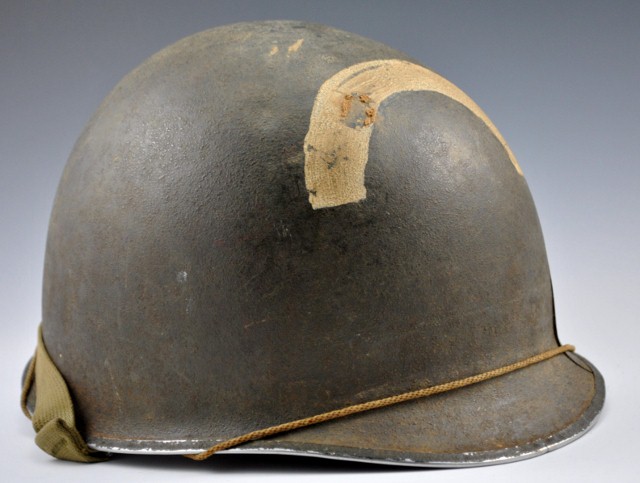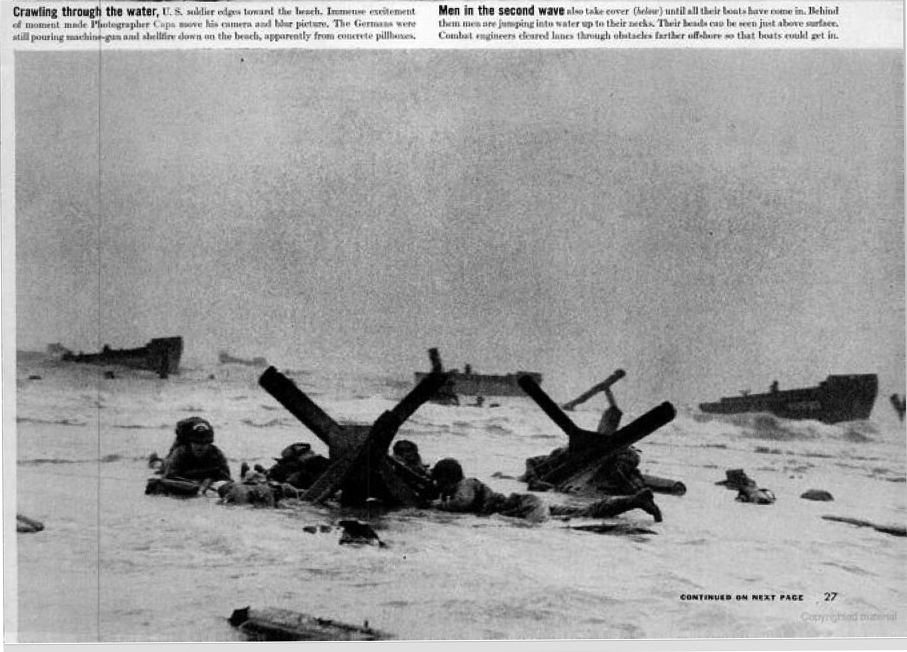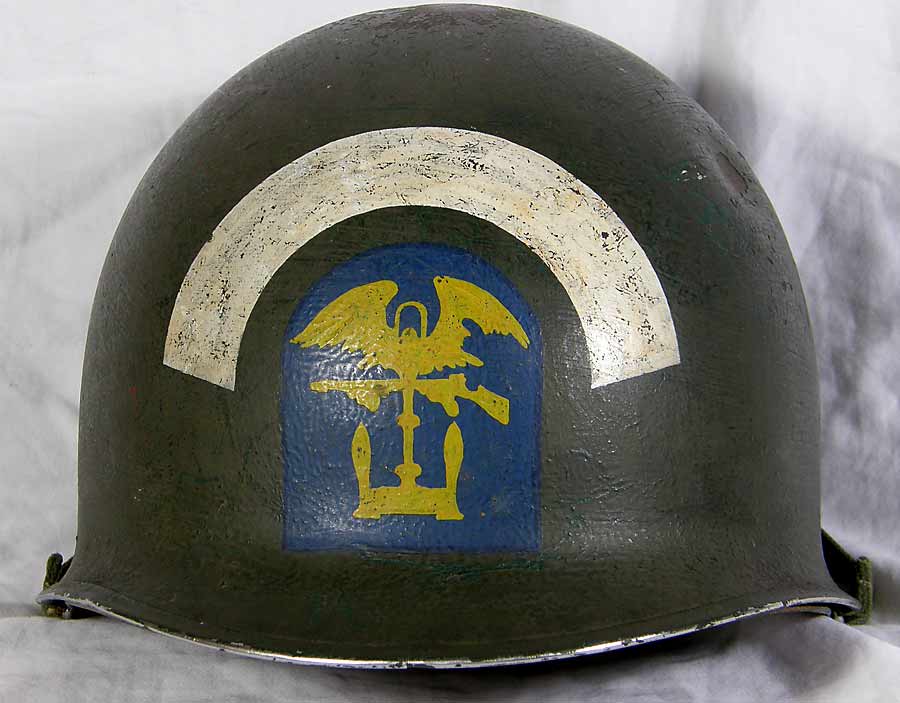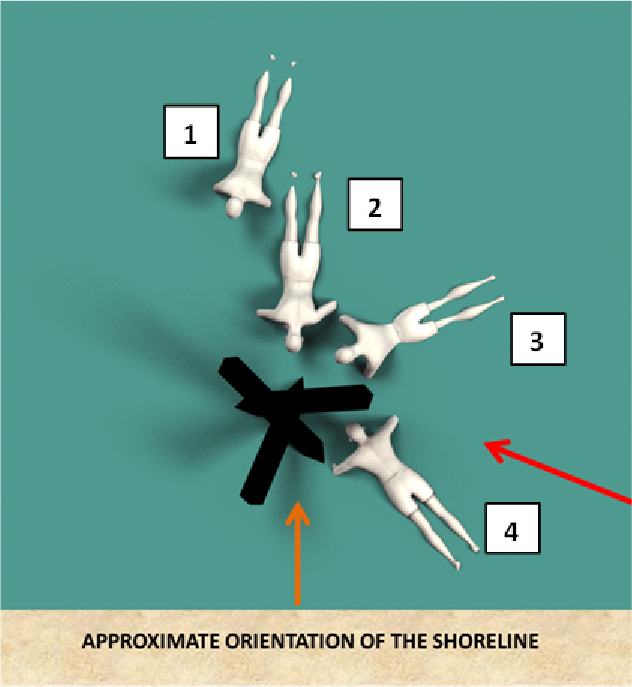[Editor’s Note: Between late February and early March of this year, Charles Herrick, then unknown to me, appended a set of cogent, knowledgeable, and useful comments to several of photojournalist Ross Baughman’s posts about Capa’s time on Omaha Beach on D-Day. That led me to initiate a correspondence, which in turn prompted him to revisit some research he’d conducted independently on the logistics of D-Day and Capa’s images in relation thereto.
Within a week or so of our first contact, Herrick sent me a carefully written, thoroughly researched, closely reasoned 40-page paper on the subject. I found all of it pertinent to this project, and extremely helpful. At my suggestion, he extracted the self-contained section published here in two parts, starting below; this contains some of the more dramatic of his findings. (Additional portions of his research will appear in a subsequent post.)
Here, for the first time, Herrick identifies the specialty and assignment of the military personnel huddled around the Nazi “hedgehogs” in Capa’s images and the activity they’re engaged in while under fire. I consider it safe to say that no one who has studied and written about these images over the past 70 years has understood what they were seeing. Herrick’s analysis exemplifies what close, careful, informed attention to the specifics of photographs can achieve. Prepare to have your eyes opened. Part 1 appears here; click here for Part 2. — A. D. C.]
•
Valor Reclaimed, Honor Restored:
Combined Demolitions Team 10 on D-Day
by Charles Herrick
If one picture is worth a thousand words, it is also true that a photograph is merely a fraction of a second frozen in time, and a split-second image cannot fully tell a story. A basketball player driving toward the hoop may make a great subject for an action shot, but how does the action end? Does it lead up to a game-winning shot? A miss? Was the ball stolen away right after the photo was taken?
The value — and meaning — of a photo can depend entirely on an accompanying caption that explains the context and significance of the image. Without captions, single images can serve as a form of Rorschach test, with the viewer using his or her own perceptual bias to fill in the ambiguity of the photo. If the viewer has little knowledge of the subject matter, the value and meaning of the photo can be lost. Hence captions become an essential accompaniment to many photos, ensuring that the stories in those photos are understood.
Unfortunately, reliance on captions can also lead to complete misunderstanding. An incomplete or incorrect caption can skew the viewer’s perception of the image, leading to a totally inaccurate interpretation.
And therein lies our tale of Combined Demolitions Unit 10, its heroic accomplishments on Omaha Beach, and its descent into photojournalistic and historical oblivion.*
•
Our tale begins, naturally, with a photo. It was taken by combat photographer Robert Capa on Omaha Beach during the first hours of D-Day, June 6, 1944. We have fewer than a dozen of his D-Day photos, and because no other photos were taken on Omaha Beach in the initial hours of the landing, Capa’s images serve as the de facto face of the invasion. They have become iconic by default.
Our photo is a positive printed from Capa’s negative 35, one of two nearly identical shots (negative 36 being the other), as reproduced in LIFE magazine on June 19, 1944. The focal point of the image is a group of men gathered around a beach obstacle, one of whom is often identified as a corpse. [The Germans planted hundreds of these obstacles — invented by the Czech military, and commonly referred to as “hedgehogs” — along the Atlantic Wall. — Ed.] Slightly to the right and rear is another hedgehog, with at least one man partially obscured by that obstacle. In the center rear are a log ramp obstacle and a pole obstacle; two men are visible at the pole obstacle. Behind these are three landing craft heading in to the beach.
After Capa left the beach early that morning on LCI(L)-94, he and his film eventually made it back to Weymouth, England. Capa sent the film by courier to LIFE magazine’s offices in London, without explanatory notes. Captioning the images was therefore left to those who had never witnessed an amphibious assault, much less the Omaha Beach landings.
By the time that film reached LIFE‘s head offices in New York on June 10, the dreadful story of soldiers pinned down and slaughtered in the surf had become a major news theme. A cursory glance at negative 35 appeared to illustrate precisely that theme. As a result, LIFE editors added the following caption when that photo was printed in the June 19, 1944 edition of the magazine:
“Men in the second wave also take cover until all their boats have come in. Behind them men are jumping into water up to their necks. Their heads can be seen just above surface. Combat engineers cleared lanes through obstacles farther off shore so that boats could get in.”
And with this piece of inventive fiction written by stateside editors, that interpretation of the photo, accurate or not, became cemented in the popular imagination. Knowing no better, the American public accepted it as gospel for more than 70 years.
This narrative was echoed in scores of later books and articles on D-Day. With only Capa’s 10 photos available to represent the initial landings from the beach perspective, commentators and historians have used those photos almost indiscriminately to illustrate a wide variety of Omaha Beach topics, with little attention paid to accuracy. In the absence of other relevant imagery, they quickly became the still-photography equivalent of B-roll footage.
Even the Army’s official history of the Omaha landings (Omaha Beachhead, 6 June – 13 June 1944) fell into this trap. On page 51, it included a reproduction of the image from negative 35, explaining it with this caption:
“The obstacles were used as shelter by assault troops facing the task of crossing the tidal flats under full exposure to enemy fire, but the delay often resulted in heavier losses. Landing craft in the background are having trouble in the outer obstacles.”
One problem with the “men pinned down in the surf” narrative was that while it was true at many points on Omaha Beach — especially in front of the heavily defended beach exits — Combined Demolitions Unit 10 and Capa himself landed at a stretch that was under relatively light fire. This fact led to that section of beach becoming the springboard for one of the decisive advances on D-Day. So, when LIFE‘s editors added a caption that was accurate in the macro sense — but wholly inaccurate for that particular scene — they condemned the photo to misreading for decades to come.
•

Robert Capa, D-Day negative 35, detail (l) and computer-generated model (r). Illustration © 2015 by Charles Herrick.
Let’s take a fresh look at Capa’s negative 35, free from the bias of the captions. You see it here alongside a computer-generated re-creation of the figures in the picture and their relative positions. (Click to enlarge.)
Now, taking this model, viewing it from above, and orienting it in relation to the shoreline, an important fact becomes obvious: Only one of the figures (2) is positioned in such a way that the hedgehog will protect him against frontal fire from the beach (indicated by the orange arrow). The top figure (1) is just too far back for the hedgehog to be useful as shelter. Neither of the two figures on the right (3 or 4) is covered by the hedgehog. (Click to enlarge.)
The situation appears even more perilous when taking the red arrow into account. That arrow indicates the approximate direction of fire coming from the nearest German strongpoint some 400-500 yards distant (guarding the E-3 draw). That was the source of the major fire directed onto this section of the beach throughout the morning. Yet, as the red arrow indicates, not a single figure in the representation is shielded from this fire by the hedgehog. So the men in Capa’s negative 35 clearly are not seeking shelter at the hedgehog, as the traditional interpretation would have us believe.
Which raises this question: If they aren’t seeking shelter, just what are they doing?
(Part 1 I 2)
Text copyright © 2015 by Charles Herrick. Illustrations © Charles Herrick 2015 as noted. All rights reserved.
•
(For an index of links to all posts in this series, click here.)
•
Charles Herrick joined the U.S. Army in 1970 and graduated from the U.S. Military Academy at West Point in 1974. Commissioned in the Infantry, he earned the Ranger tab and Master Parachutist’s wings. He served in a variety of positions from company grade officer to the Pentagon. He earned the Combat Infantryman’s badge while assigned as the Operations Officer of the 193rd Infantry Brigade in Panama in 1989, and later graduated from the U.S. Army War College.
Since retiring from the Army in 1996, Herrick has continued to work on defense issues as a contractor in East Asia, Latin America, the Balkans, Africa and Central Asia. He holds an MBA from the University of California at Los Angeles. He lives in California with his wife, where he pursues his passion for military history. To contact Charles Herrick, click here.











Fascinating! Thanks.
Kent